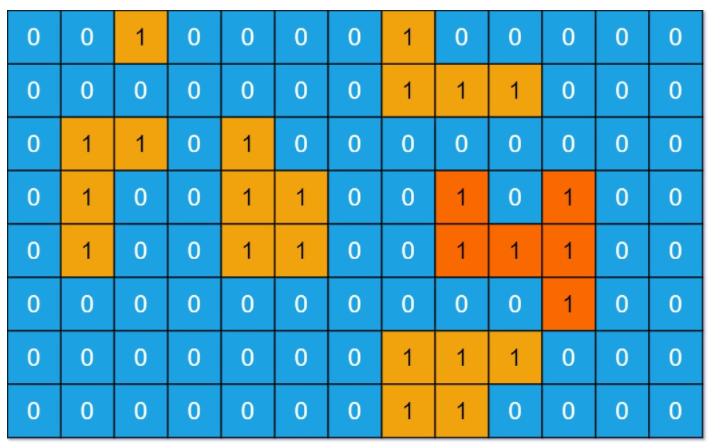.gif)
Description
You are given an m x n binary matrix grid. An island is a group of 1's (representing land) connected 4-directionally (horizontal or vertical.) You may assume all four edges of the grid are surrounded by water.
The area of an island is the number of cells with a value 1 in the island.
Return the maximum area of an island in grid. If there is no island, return 0.
Example 1:

Input: grid = [
[0,0,1,0,0,0,0,1,0,0,0,0,0],[0,0,0,0,0,0,0,1,1,1,0,0,0],
[0,1,1,0,1,0,0,0,0,0,0,0,0],[0,1,0,0,1,1,0,0,1,0,1,0,0],
[0,1,0,0,1,1,0,0,1,1,1,0,0],[0,0,0,0,0,0,0,0,0,0,1,0,0],
[0,0,0,0,0,0,0,1,1,1,0,0,0],[0,0,0,0,0,0,0,1,1,0,0,0,0]
]
Output: 6
Explanation: The answer is not 11, because the island must be connected 4-directionally.Example 2:
Input: grid = [[0,0,0,0,0,0,0,0]]
Output: 0Solution
var maxAreaOfIsland = function(grid) {
if (grid.length == 0) return 0;
let height = grid.length, width = grid[0].length;
let max = 0;
for (let row = 0; row < height; row++) {
for (let col = 0; col < width; col++) {
if (grid[row][col] == 1) {
max = Math.max(max, dfs(row, col, grid));
}
}
}
return max;
};
function dfs(r, c, grid) {
if (r < 0 || r >= grid.length || c < 0 || c >= grid[0].length
|| grid[r][c] === 0) return 0;
const DIRECTIONS = [[-1,0], [0,1], [1,0], [0,-1]];
let count = 1;
grid[r][c] = 0;
for (let dir of DIRECTIONS) {
count += dfs(r + dir[0], c + dir[1], grid);
}
return count;
}